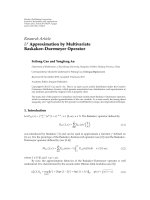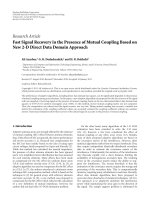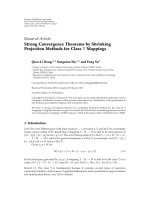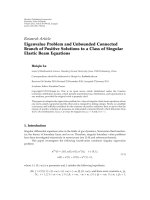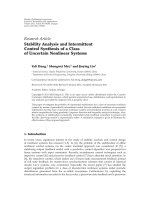báo cáo hóa học:" Research Article Viscosity Approximation to Common Fixed Points of Families of Nonexpansive Mappings with Weakly Contractive Mappings" docx
Bạn đang xem bản rút gọn của tài liệu. Xem và tải ngay bản đầy đủ của tài liệu tại đây (473.42 KB, 8 trang )
Hindawi Publishing Corporation
Fixed Point Theory and Applications
Volume 2010, Article ID 476913, 8 pages
doi:10.1155/2010/476913
Research Article
Viscosity Approximation to Common Fixed
Points of Families of Nonexpansive Mappings with
Weakly Contractive Mappings
A. Razani
1, 2
and S. Homaeipour
1
1
Department of Mathematics, Faculty of Science, Imam Khomeini International University,
P.O. Box 34149-16818, Qazvin, Iran
2
School of Mathematics, Institute for Research in Fundamental Sciences,
P.O. Box 19395-5746, Tehran, Iran
Correspondence should be addressed to S. Homaeipour, s
Received 5 June 2010; Accepted 26 July 2010
Academic Editor: Brailey Sims
Copyright q 2010 A. Razani and S. Homaeipour. This is an open access article distributed under
the Creative Commons Attribution License, which permits unrestricted use, distribution, and
reproduction in any medium, provided the original work is properly cited.
Let X be a reflexive Banach space which has a weakly sequentially continuous duality mapping. In
this paper, we consider the following viscosity approximation sequence x
n
λ
n
fx
n
1−λ
n
T
n
x
n
,
where λ
n
∈ 0, 1, {T
n
} is a uniformly asymptotically regular sequence, and f is a weakly contractive
mapping. Strong convergence of the sequence {x
n
} is proved.
1. Introduction
Let C be a nonempty closed convex subset of a Banach space X. Recall that a self-mapping
T : C → C is nonexpansive if
T
x
− T
y
≤
x − y
∀x, y ∈ C. 1.1
Alber and Guerre-Delabriere 1 defined the weakly contractive maps in Hilbert spaces, and
Rhoades 2 showed that the result of 1 is also valid in the complete metric spaces as follows.
Definition 1.1. Let X, d be a complete metric space. A mapping T : X → X is called weakly
contractive if
d
Tx,Ty
≤ d
x, y
− ψ
d
x, y
, 1.2
2 Fixed Point Theory and Applications
where x,y ∈ X and ψ : 0, ∞ → 0, ∞ is a continuous and nondecreasing function such
that ψt0 if and only if t 0 and lim
t →∞
ψt∞.
Theorem 1.2. Let T : X → X be a weakly contractive mapping, where X, d is a complete metric
space, then T has a unique fixed point.
In 2007, Song and Chen 3 considered the iterative sequence
x
n
λ
n
f
x
n
1 − λ
n
T
n
x
n
,n∈
{
1, 2,
}
. 1.3
They proved the strong convergence of the iterative sequence {x
n
}, where f is a contraction
mapping and {T
n
} is a uniformly asymptotically regular sequence of nonexpansive mappings
in a reflexive Banach space X, as follows.
Theorem 1.3 see 3, Theorem 3.1. Let X be a reflexive Banach space which admits a weakly
sequentially continuous duality mapping J from X to X
∗
. Suppose that C is a nonempty closed convex
subset of X and {T
n
},n ∈{1, 2, }, is a uniformly asymptotically regular sequence of nonexpansive
mappings from C into itself such that
F :
∞
n1
Fix
T
n
/
∅,
1.4
where FixT
n
: {x ∈ C : x T
n
x},n ∈{1, 2, }.Let{x
n
} be defined by 1.3 and λ
n
∈ 0, 1,
such that lim
n →∞
λ
n
0.Thenasn →∞, the sequence {x
n
} converges strongly to p, such that p is
the unique solution, in F, to the variational inequality:
f
p
− p, J
y − p
≤ 0, ∀y ∈ F. 1.5
In this paper, inspired by the above results, strong convergence of sequence 1.3 is
proved, where f is a weakly contractive mapping.
2. Preliminaries
A Banach space X is called strictly convex if
x
y
1,x
/
y implies
x y
2
< 1.
2.1
A Banach space X is called uniformly convex, if for all ε ∈ 0, 2, there exist δ
ε
> 0 such that
x
y
1with
x − y
≥ ε implies that
x y
2
< 1 − δ
ε
.
2.2
The following results are well known which can be founded in 4.
Fixed Point Theory and Applications 3
1 A uniformly convex Banach space X is reflexive and strictly convex.
2 If C is a nonempty convex subset of a strictly convex Banach space X and T : C → C
is a nonexpansive mapping, then the fixed point set FT of T is a closed convex
subset of C.
By a gauge function we mean a continuous strictly increasing function ϕ defined on 0, ∞
such that ϕ00 and lim
r →∞
ϕr∞. The mapping J
ϕ
: X → 2
X
∗
defined by
J
ϕ
x
x
∗
∈ X
∗
:
x, x
∗
x
x
∗
,
x
∗
ϕ
x
, for each x ∈ X, 2.3
is called the duality mapping with gauge function ϕ. In the case where ϕtt, then J
ϕ
J
which is the normalized duality mapping.
Proposition 2.1 see 5. (1) J I if and only if X is a Hilbert space.
(2) J is surjective if and only if X is reflexive.
(3) J
ϕ
λxsign λϕ|λ|·x/xJx for all x ∈ X \{0},λ ∈ R; in particular J−x
−Jx, for all x ∈ X.
We say that a Banach space X has a weakly sequentially continuous duality mapping
if there exists a gauge function ϕ such that the duality mapping J
ϕ
is single-valued and
continuous from the weak topology to the weak
∗
topology of X.
We recall 6 that a Banach space X is said to satisfy Opial’s condition, if for any
sequence {x
n
} in X, which converges weakly to x ∈ X, we have
lim sup
n →∞
x
n
− x
< lim sup
n →∞
x
n
− y
∀y ∈ X, y
/
x.
2.4
It is known 7 that any separable Banach space can be equivalently renormed such that it
satisfies Opial’s condition. A space with a weakly sequentially continuous duality mapping
is easily seen to satisfy Opial’s condition 8.
Lemma 2.2 see 9, Lemma 4. Let X be a Banach space satisfying Opial’s condition and C a
nonempty, closed, and convex subset of X. Suppose that T : C → C is a nonexpansive mapping. Then
I − T is demiclosed at zero, that is, if {x
n
} is a sequence in C which converges weakly to x and if the
sequence x
n
− Tx
n
converges strongly to zero, then x − Tx 0.
Definition 2.3 see 3.LetC be a nonempty closed convex subset of a Banach space X and
T
n
: C → C, where n ∈{1, 2, }. Then the mapping sequence {T
n
} is called uniformly
asymptotically regular on C, if for all m ∈{1, 2, } and any bounded subset K of C we have
lim
n → ∞
sup
x∈K
T
m
T
n
x
− T
n
x
0.
2.5
3. Main Result
In this section, we prove a new version of Theorem 1.3.
4 Fixed Point Theory and Applications
Theorem 3.1. Let X be a reflexive Banach space which admits a weakly sequentially continuous
duality mapping J from X to X
∗
. Suppose that C is a nonempty closed convex subset of X and T
m
:
C → C, m ∈{1, 2, }, is a uniformly asymptotically regular sequence of nonexpansive mappings
such that
F :
∞
m1
Fix
T
m
/
∅.
3.1
Let f : C → C be a weakly contractive mapping. Suppose that {t
m
} is a sequence of positive numbers
in 0, 1 satisfying lim
m →∞
t
m
0. Assume that {x
m
} is defined by the following iterative process:
x
m
t
m
f
x
m
1 − t
m
T
m
x
m
,m∈
{
1, 2,
}
. 3.2
Then the above sequence {x
m
} converges strongly to a common fixed point p of {T
m
},m ∈{1, 2, }
such that p is the unique solution, in F, to the variational inequality
f
p
− p, J
y − p
≤ 0, ∀y ∈ F. 3.3
Proof.
Step 1. We prove the uniqueness of the solution to the variational inequality 3.3.Suppose
that p, q ∈ F are distinct solutions to 3.3. Then
f
p
− p, J
q − p
≤ 0,
f
q
− q, J
p − q
≤ 0.
3.4
By adding up the above relations, we get
0 ≥
p − f
p
−
q − f
q
,J
p − q
≥p − q, J
p − q
−
f
p
− f
q
,J
p − q
≥
p − q
2
−
f
p
− f
q
J
p − q
≥
p − q
2
−
p − q
2
ψ
p − q
p − q
.
3.5
Thus ψp − qp − q≤0, hence p q. We denote by p the unique solution, in F,to3.3.
Fixed Point Theory and Applications 5
Step 2. We show that the sequence {x
m
} is bounded. Let q ∈ F;from3.2 we get then that
x
m
− q
2
t
m
f
x
m
− q
1 − t
m
T
m
x
m
− q
,J
x
m
− q
t
m
f
x
m
− f
q
f
q
− q
,J
x
m
− q
1 − t
m
T
m
x
m
− T
m
q, J
x
m
− q
≤ t
m
f
x
m
− f
q
J
x
m
− q
t
m
f
q
− q, J
x
m
− q
1 − t
m
T
m
x
m
− T
m
q
J
x
m
− q
≤ t
m
x
m
− q
− ψ
x
m
− q
x
m
− q
f
q
− q, J
x
m
− q
1 − t
m
T
m
x
m
− T
m
q
J
x
m
− q
≤ t
m
x
m
− q
2
− ψ
x
m
− q
x
m
− q
f
q
− q, J
x
m
− q
1 − t
m
x
m
− q
2
≤
x
m
− q
2
− t
m
x
m
− q
ψ
x
m
− q
t
m
f
q
− q
x
m
− q
.
3.6
Thus
x
m
− q
ψ
x
m
− q
≤
f
q
− q
x
m
− q
, 3.7
or
ψ
x
m
− q
≤
f
q
− q
. 3.8
Therefore {x
m
} is bounded.
Step 3. We prove that lim
m → ∞
x
m
− T
n
x
m
0, for all n ∈{1, 2, }. Since the sequence {x
m
}
is bounded, so {fx
m
} and {T
m
x
m
} are bounded. Hence lim
m →∞
t
m
T
m
x
m
− fx
m
0, thus
lim
m →∞
x
m
− T
m
x
m
0. Let K be a bounded subset of C which contains {x
m
}. Since the
sequence {T
m
} is uniformly asymptotically regular, we can obtain
lim
m →∞
T
n
T
m
x
m
− T
m
x
m
≤ lim
m →∞
sup
x∈K
T
n
T
m
x
− T
m
x
0.
3.9
Let m →∞, then
x
m
− T
n
x
m
≤
x
m
− T
m
x
m
T
m
x
m
− T
n
T
m
x
m
T
n
T
m
x
m
− T
n
x
m
≤ 2
x
m
− T
m
x
m
T
m
x
m
− T
n
T
m
x
m
−→ 0.
3.10
Hence lim
m →∞
x
m
− T
n
x
m
0, for all n ∈{1, 2, }.
6 Fixed Point Theory and Applications
Step 4. We show that the sequence {x
m
} is sequentially compact. Since X is reflexive and {x
m
}
is bounded, there exists a subsequence {x
m
k
} of {x
m
} such that {x
m
k
} is weakly convergent
to q ∈ C as k →∞. Since lim
k →∞
x
m
k
− T
n
x
m
k
0 for all n ∈{1, 2, },byLemma 2.2,we
have q T
n
q for all n ∈{1, 2, }.Thusq ∈ F.
Step 2 implies that
x
m
k
− q
2
≤ t
m
k
x
m
k
− q
− ψ
x
m
k
− q
x
m
k
− q
f
q
− q, J
x
m
k
− q
1 − t
m
k
x
m
k
− q
2
.
3.11
Hence
t
m
k
x
m
k
− q
ψ
x
m
k
− q
≤ t
m
k
f
q
− q, J
x
m
k
− q
. 3.12
Since J is single valued and weakly sequentially continuous from X to X
∗
, we have
lim sup
k →∞
x
m
k
− q
ψ
x
m
k
− q
≤ lim
k →∞
f
q
− q, J
x
m
k
− q
0.
3.13
Thus lim
k →∞
x
m
k
q. Hence the sequence {x
m
} is sequentially compact.
Step 5. We now prove that q ∈ F is a solution to the variational inequality 3.3. Suppose that
y ∈ F, then
x
m
− y
2
t
m
f
x
m
− x
m
x
m
− y
,J
x
m
− y
1 − t
m
T
m
x
m
− T
m
y, J
x
m
− y
≤ t
m
f
x
m
− x
m
,J
x
m
− y
x
m
− y
2
.
3.14
Hence
f
x
m
− x
m
,J
y − x
m
≤ 0 for each m ∈
{
1, 2,
}
. 3.15
Since {x
m
k
}→q as k →∞, we have
x
m
k
− f
x
m
k
−
q − f
q
−→ 0ask −→ ∞ ,
x
m
k
− f
x
m
k
,J
x
m
k
− y
−
q − f
q
,J
q − y
x
m
k
− f
x
m
k
−
q − f
q
,J
x
m
k
− y
q − f
q
,J
x
m
k
− y
− J
q − y
≤
x
m
k
− f
x
m
k
−
q − f
q
x
m
k
− y
q − f
q
,J
x
m
k
− y
− J
q − y
−→ 0,
3.16
Fixed Point Theory and Applications 7
as k →∞. Hence
f
q
− q, J
y − q
lim
k →∞
f
x
m
k
− x
m
k
,J
y − x
m
k
≤ 0.
3.17
Thus q ∈ F is a solution to the variational inequality 3.3. By uniqueness, q p. Since the
sequence {x
m
} is sequentially compact and each cluster point of it is equal to p, then {x
m
}→
p as m →∞. The proof is completed.
It is known that 10, Example 2 in a uniformly convex Banach space E,theCes
`
aro
means T
n
1/n
n−1
j0
T
j
for nonexpansive mapping T is uniformly asymptotically regular.
So we have the following corollary, which is a new version of 10, Theorem 3.2.
Corollary 3.2. Let X be a real uniformly convex Banach space which admits a weakly sequentially
continuous duality mapping J from X to X
∗
and C a nonempty closed convex subset of X. Suppose
that T : C → C is a nonexpansive mapping, FT
/
∅ and f : C → C is a weakly contractive
mapping. Let {z
m
} be defined by
z
m
t
m
f
z
m
1 − t
m
1
m 1
Σ
m
j0
T
j
z
m
,m≥ 0,
3.18
where t
m
∈ 0, 1 and lim
m →∞
t
m
0.Thenasm →∞, {z
m
} converges strongly to a fixed point p
of T,wherep is the unique solution in FT to the f ollowing variational inequality:
f
p
− p, j
u − p
≤ 0 ∀u ∈ F
T
. 3.19
Acknowledgment
A. Razani would like to thank the School of Mathematics of the Institute for Research in
Fundamental Sciences, Teheran, Iran for supporting this paper Grant no.89470126.
References
1 Ya. I. Alber and S. Guerre-Delabriere, “Principle of weakly contractive maps in Hilbert spaces,” in New
Results in Operator Theory and Its Applications, vol. 98 of Operator Theory: Advances and Applications, pp.
7–22, Birkh
¨
auser, Basel, Switzerland, 1997.
2 B. E. Rhoades, “Some theorems on weakly contractive maps,” Nonlinear Analysis: Theory, Methods &
Applications, vol. 47, pp. 2683–2693, 2001.
3 Y. Song and R. Chen, “Iterative approximation to common fixed points of nonexpansive mapping
sequences in reflexive Banach spaces,” Nonlinear Analysis: Theory, Methods & Applications, vol. 66, no.
3, pp. 591–603, 2007.
4 W. Takahashi, Nonlinear Functional Analysis. Fixed Point Theory and Its Applications, Yokohama,
Yokohama, Japan, 2000.
5 Z. B. Xu and G. F. Roach, “Characteristic inequalities of uniformly convex and uniformly smooth
Banach spaces,” Journal of Mathematical Analysis and Applications, vol. 157, no. 1, pp. 189–210, 1991.
6 Z. Opial, “Weak convergence of the sequence of successive approximations for nonexpansive
mappings,” Bulletin of the American Mathematical Society, vol. 73, pp. 591–597, 1967.
7 D. van Dulst, “Equivalent norms and the fixed point property for nonexpansive mappings,” Journal
of the London Mathematical Society, vol. 25, no. 1, pp. 139–144, 1982.
8 F. E. Browder, “Convergence theorems for sequences of nonlinear operators in Banach spaces,”
Mathematische Zeitschrift, vol. 100, pp. 201–225, 1967.
8 Fixed Point Theory and Applications
9 J. G´ornicki, “Weak convergence theorems for asymptotically nonexpansive mappings in uniformly
convex Banach spaces,” Commentationes Mathematicae Universitatis Carolinae, vol. 30, no. 2, pp. 249–
252, 1989.
10 Y. Song and R. Chen, “Viscosity approximate methods to Ces
`
aro means for non-expansive mappings,”
Applied Mathematics and Computation, vol. 186, no. 2, pp. 1120–1128, 2007.




